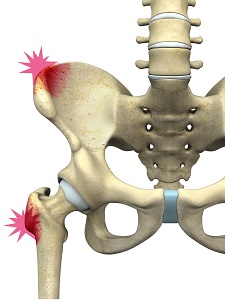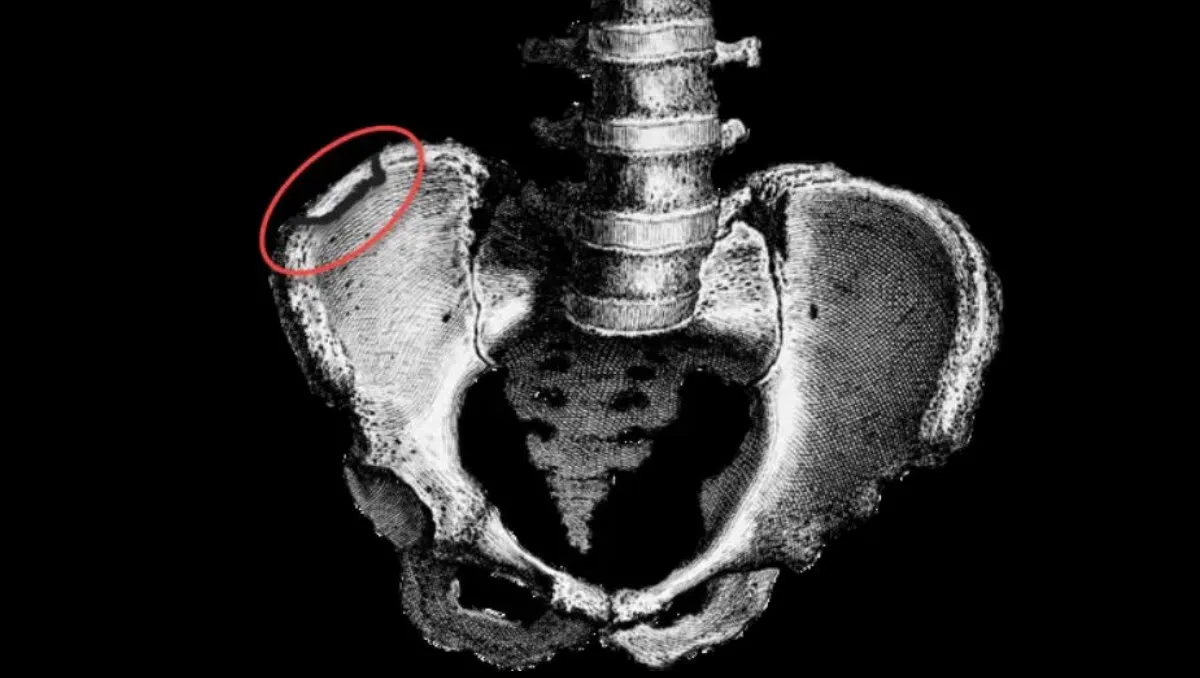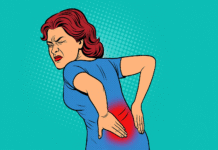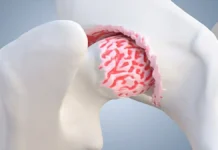A hip pointer is a deep bruise at the iliac crest and/or the upper outer part of the hip. It is often the result of a direct blow to the hip or a sharp fall. This area is less protected because it has minimal fatty tissue coverage, making it more susceptible to trauma.
Introduction
The hip, a crucial element of our daily mobility, is often exposed to various types of trauma, among which contusion, or bruise, stands out as a frequent injury. This condition usually occurs following direct impact or physical trauma, and its manifestations include pain, swelling, and skin discoloration.
To fully understand the complexities of hip contusion, it is necessary to go beyond its simple superficial presentation. This in-depth exploration aims to analyze not only the characteristic symptoms, but also the crucial differential diagnosis aimed at excluding other conditions with similar symptoms. Understanding hip contusion in the overall medical context is of paramount importance to ensure proper management and effective recovery.
By delving into the intricacies of this common injury, this analysis aspires to provide illuminating information on symptoms, underlying causes, differential diagnosis, and treatment approaches. This will help provide a holistic understanding of this prevalent condition affecting the hip region.
The symptoms of a hip contusion go beyond just bruising. The pain, often intense, can persist for a prolonged period, affecting the patient’s mobility and comfort. Swelling around the affected area is common, adding to the overall discomfort. Skin discoloration, the result of blood accumulation under the skin, is a typical visual manifestation.

However, it is crucial to recognize that other medical conditions may present with similar symptoms, hence the importance of differential diagnosis. More serious injuries, such as hip fractures, can also cause pain, swelling, and skin discoloration. A thorough examination, sometimes accompanied by medical imaging tests, is necessary to accurately distinguish the contusion from other potential conditions.
Treating a hip contusion often involves simple but effective approaches. Rest and application of ice in the first hours after injury help reduce inflammation. Elevating the affected leg can also help decrease swelling. Over-the-counter pain relievers can be used to relieve pain.
Causes
Hip contusions can have a variety of causes, mostly related to direct impacts or physical trauma. One of the most common causes is a fall, where a person lands directly on the hip as a result of an imbalance or accident. Sports activities can also be a common source of hip bruises, especially in contact sports or those involving frequent falls.
Traffic accidents, such as vehicle collisions, can result in significant bruising to the hip because the forces generated during impact are often absorbed by this region of the body. Likewise, domestic accidents, such as falls down stairs, can cause significant trauma to the hip, causing bruising.
Hip bruises can also result from everyday activities, including hitting hard objects. For example, hitting a coffee table or hitting the hip against a corner of furniture can cause a person to bruise. Workplace accidents, especially in environments where there is an increased risk of impacts or falls, represent another potential source of hip contusions.
People who engage in strenuous physical activities, such as weightlifting, may also be prone to hip bruises, often caused by handling heavy weights or sports equipment. Additionally, older adults, due to decreased bone density and increased fragility, are more likely to sustain bruises from relatively minor falls.
It is important to note that certain underlying medical conditions can increase vulnerability to hip contusions. Blood clotting disorders, such as hemophilia, can lead to more frequent and larger bruising in cases of trauma. Likewise, people taking blood thinners may be at increased risk of bleeding and bruising following injuries.
- Direct Trauma: The most common way to develop a hip contusion is from direct impact with a hard object or surface, such as a fall to the side or a blow with a blunt object.
- Falls: Falls, whether slipping, tripping, or falling, can result in hip bruising, particularly if the side of the hip comes into contact with a hard surface.
- Sports Activities: Contact sports, collision sports or strenuous physical activities can increase the risk of hip bruises due to frequent collisions or impacts.
- Traffic Accidents: Car accidents, bicycle accidents, or other traffic accidents can result in direct trauma to the hip, causing bruising.
- Improper Exercise Technique: Improper technique when exercising, especially with rotating or twisting movements, can cause hip injuries.
- Medical Conditions: Certain pre-existing medical conditions, such as blood clotting disorders, may increase the likelihood of bruising.
Symptoms
Hip contusions manifest through various symptoms, offering clues to the severity of the injuries. Pain is the predominant symptom, usually beginning as a sharp sensation at the time of injury and often lasting for several days. It can be exacerbated by pressure, movement or even rest. Swelling, resulting from fluid accumulation in surrounding tissues, is common, limiting range of motion and contributing to discomfort. Skin discoloration, in the form of a bruise, develops in the days following the bruise, providing a visual indicator of severity. Sensitivity to touch can make the bruised area uncomfortable to touch. In more severe cases, the person may have difficulty bearing weight on the affected leg, leading to lameness or discomfort when walking. The severity of symptoms depends on factors such as the intensity of the impact and the depth of the bruise. A medical consultation is recommended in the event of persistent symptoms, excessive swelling or any difficulty with mobility, allowing for an accurate diagnosis and an appropriate treatment plan to promote effective recovery.
- Pain: Pain is one of the most common symptoms. It may be felt at the site of impact and may extend to the surrounding area of the hip.
- Sensitivity to Touch: The affected area may be sensitive to touch. Even light pressure can cause discomfort.
- Swelling: A bruise can cause swelling in the affected area. This may be due to the body’s inflammatory response to the injury.
- Skin Discoloration: Skin discoloration, often in the form of a bruise (blue or purple), may develop as blood accumulates under the skin.
- Stiffness: The affected area may become stiff due to inflammation and the body’s protective muscular response.
- Limitation of Mobility: Due to pain and stiffness, there may be limitation of mobility of the affected hip.
- Numbness or Tingling: In some cases, numbness or tingling sensations may be felt, although this is less common.
Differential diagnosis
- Hip Fracture: A hip fracture can cause pain, swelling and difficulty moving. An x-ray is often necessary to distinguish a fracture from a bruise.
- Joint Sprain or Dislocation: Injuries to the ligaments or dislocation of the hip joint can also cause pain and reduced mobility.
- Hip Bursitis: Inflammation of the bursa (small bag of fluid near the hip joint) can cause pain and swelling similar to that of a bruise.
- Deep Hematoma: A deeper hematoma in the tissues can occur without affecting the skin directly and can cause similar symptoms.
- Infection: A hip infection can cause pain, swelling, and other symptoms. However, this is less common than bruises or sprains.
- Bone Diseases: Conditions such as osteoporosis can increase the risk of fractures.
- Inguinal Hernia: An inguinal hernia can cause pain in the groin area, which can sometimes be confused with a bruise.
- Tumors or Masses: Although less common, tumors or masses in the hip area can cause symptoms similar to a bruise.
Osteopathic Diagnosis and Evaluation
Osteopathic diagnosis of a hip contusion involves a thorough evaluation of symptoms, medical history, and specific physical examinations. Osteopaths use manual techniques and mobility assessments to determine the severity of the bruise and design a personalized treatment plan. Here are the main stages of this evaluation:
- History:
- Osteopaths begin by collecting detailed information about the circumstances of the injury, the nature of the symptoms, the medical history and the patient’s level of physical activity.
- Physical examination :
- Osteopaths perform a thorough clinical examination assessing hip mobility, muscle strength, joint stability and skin sensation in the affected area.
- Palpation:
- The use of palpation allows osteopaths to precisely locate the contusion area, identify painful points, and detect possible movement restrictions in soft tissues and joints.
- Mobility Tests:
- Osteopaths perform specific tests to assess hip mobility, including extension, abduction, adduction, rotation, and flexion movements. Restrictions in these movements may indicate muscle or joint problems.
- Postural Assessment:
- A posture assessment may reveal compensations or changes in body alignment in response to the contusion. Osteopaths examine how the injury may have influenced the patient’s overall posture.
- Additional tests :
- If necessary, imaging tests such as X-rays, ultrasounds, or MRIs may be recommended to assess the severity of the contusion and rule out other injuries.
- Differential diagnosis :
- Osteopaths rule out other possible conditions with similar symptoms, such as fractures, sprains or underlying joint problems.
Osteopathic Treatment of Hip Contusions
When it comes to treating hip bruises, osteopaths take a holistic approach focused on relieving pain, reducing inflammation and promoting optimal healing. Here are the main osteopathic approaches used in the treatment of hip contusions:
- Myofascial release:
- By working on the muscles and fascia surrounding the hip, osteopaths use myofascial release techniques to reduce muscle tension, improve blood circulation, and promote faster recovery.
- Targeted Stretches:
- Specific stretching exercises may be recommended to improve the flexibility of the muscles around the hip. This helps prevent stiffness and restore normal range of motion.
- Energy Release Techniques:
- Some osteopaths use energy release techniques to promote an energetic balance in the body, supporting the natural healing process.
- Advice on Physical Activity:
- Osteopaths can provide advice on physical activities appropriate for the healing phase, emphasizing the importance of maintaining light physical activity to avoid stiffness and stimulate blood circulation.
- Relaxation and Stress Management Techniques:
- Relaxation is essential to promote healing. Osteopaths may recommend relaxation techniques to reduce stress, which may contribute to faster recovery.
- Monitoring and Adjustments:
- Osteopaths create a personalized treatment plan and make adjustments based on the patient’s response to treatment. Follow-up sessions are often recommended to monitor progress.
Post-Contusion Rehabilitation and Exercises
- Gentle Stretching:
- Hip Flexors: Perform stretches to release the hip flexors in a kneeling position, tilting the pelvis forward.
- Adductors: Adductor stretches, whether seated or standing, can improve flexibility in the groin area.
- Progressive Muscle Strengthening:
- Strengthening Exercises: Incorporate progressive strengthening exercises for the hip muscles, including the flexors, extensors, abductors and rotators.
- Isometric Exercises: Initiate rehabilitation with isometric exercises to strengthen muscles without excessive joint movement.
- Hip Stabilization:
- Balance Exercises: Work on balance exercises, such as standing on one leg, to improve hip stability.
- Light Cardio:
- Walking, Swimming or Cycling: Introduce light cardiovascular activities to stimulate blood circulation without overloading the hip.
- Resistance Exercises:
- Resistance Bands: Use resistance bands for resistance exercises, such as lateral leg abduction, to strengthen the hip muscles.
- Postural Rehabilitation:
- Postural Awareness: Work on postural awareness to avoid compensations that could worsen the bruise.
- Massage and Self-Massage:
- Foam Roller: Use a foam roller to perform self-massage on the hip muscles to reduce tension.
- Functional Exercises:
- Simulated Movements: Incorporate progressive functional movements, such as stair climbing, to restore daily function.
- Proper Warm-up:
- Before Exercise: A proper warm-up before exercise is crucial to prepare muscles and joints.
It is imperative to progress gradually in these exercises according to individual tolerance. Always consult a healthcare professional or physical therapist before beginning a rehabilitation program, as they can tailor exercises based on the severity of the bruise and the patient’s specific needs. Regular follow-up with rehabilitation professionals can also maximize results.
Hip Contusion Prevention
Preventing hip contusions involves a combination of protective techniques, strengthening exercises and postural habits to minimize the risk of trauma. Here are some practical tips for preventing hip bruises:
- Protection Techniques:
- Wear Protective Equipment: When participating in sports or activities at risk of falls, use protective equipment such as hip protectors or padded shorts.
- Strengthening Exercises:
- Strengthen Hip Muscles: Incorporating strengthening exercises for the hip muscles, including flexors, extensors, abductors, and rotators, can strengthen the stability of the area.
- Proper warm-up:
- Prepare the Muscles and Joints: Before any intense physical activity, perform an adequate warm-up to prepare the muscles and joints for the effort.
- Regular Stretching:
- Maintain Flexibility: Incorporate regular stretching to maintain flexibility in your hip muscles and tendons.
- Caution on Slippery Surfaces:
- Be Mindful of Weather Conditions: Avoid walking or running on slippery surfaces, and be especially careful in rainy or snowy weather.
- Balance Exercises:
- Improve Balance: Practice balance exercises to strengthen hip stability and reduce the risk of falls.
- Maintaining Good Posture:
- Adopt Correct Posture: Maintain good posture when standing and sitting to reduce pressure on the hip.
- Risk Education:
- Be Aware of Potential Risks: Educate yourself about activities or situations with a high risk of bruising and take appropriate precautions.
- Wear Appropriate Footwear:
- Choose Stable Shoes: During physical activities, wear appropriate shoes that provide good support and adequate grip.
- Environmental Development:
- Avoid Obstacles: At home or at work, arrange the environment to avoid obstacles that could lead to falls.
Hip Contusions in Athletes
Hip contusions are common injuries among athletes, often resulting from direct impacts or violent shocks during sports practice. Understanding how these bruises affect athletes, the associated risks, and osteopathic approaches for rapid recovery is essential to maintaining optimal athletic performance.
Impacts on Athletes
- Pain and Discomfort: Hip contusions typically result in sharp pain at the site of impact, compromising the athlete’s ability to perform specific movements.
- Impaired Mobility: Hip mobility may be temporarily impaired due to inflammation and the body’s protective response to the injury.
- Risk of Complications: Athletes may be more likely to develop complications such as muscle strains, postural imbalances and, in some cases, reduced athletic performance.
Risks Associated with Hip Contusions in Athletes
- Delayed Healing: Due to intense physical activity and increased demand on the hip during sports, athletes may be more likely to experience delayed healing if the contusion is not treated properly.
- Repetitive Injuries: A poorly treated contusion can increase the risk of recurring injuries, compromising hip stability and function during exercise.
- Impaired Performance: Athletes may have difficulty maintaining their usual level of performance due to the pain and reduced mobility associated with the contusion.
Osteopathic Strategies for Rapid Recovery
- Precise Assessment: Osteopaths carry out a precise assessment of the contusion, identifying the affected areas and assessing the mobility and stability of the hip.
- Joint Manipulation: Gentle joint manipulation techniques are used to restore normal mobility and reduce tension in the hip region.
- Reducing Inflammation: Osteopaths may use myofascial release techniques and advice on ice application to reduce inflammation and relieve pain.
- Targeted Rehabilitation: A rehabilitation program adapted to the specific needs of the athlete is developed, including strengthening, stretching and stabilization exercises.
- Return to Training Management: Osteopaths work in collaboration with coaches and sports professionals to ensure a gradual return to training, thus minimizing the risk of relapse.
Conclusion
In conclusion, hip contusion, although often considered a minor injury, can have significant implications on an individual’s mobility and well-being. This in-depth exploration has shed light on the characteristic symptoms, potential causes, and differential diagnosis necessary to distinguish this injury from other hip conditions.
Understanding that bruising can sometimes mask more serious injuries, such as broken bones or sprains, highlights the importance of seeing a healthcare professional for a proper evaluation. Advances in the medical field, including advanced imaging tests, allow for more accurate assessment and informed treatment decisions.
Management of a hip contusion often relies on simple approaches such as rest, ice application, and elevation, but in some cases, more extensive medical intervention may be necessary. Patience and adherence to medical recommendations play a crucial role in optimal recovery.
Ultimately, a thorough understanding of hip contusions, coupled with appropriate medical evaluation, contributes to effective management of this common injury. We hope that this exploration has provided useful knowledge to better understand, treat, and ultimately recover from this condition.
References
- Frank RM, Slabaugh MA, Grumet RC, Bush-Joseph CA, Virkus WW, Nho SJ. Hip pain in active patients: what you may be missing. J Fam Pract. 2012 Dec; 61 (12):736-44. [ PubMed ]
- Kuhn AW, Noonan BC, Kelly BT, Larson CM, Bedi A. The Hip in Ice Hockey: A Current Concepts Review. Arthroscopy. 2016 Sep; 32 (9):1928-38. [ PubMed ]
- Toney-Butler TJ, Varacallo M. StatPearls [Internet]. Stat Pearls Publishing; Treasure Island (FL): Sep 5, 2020. Motor Vehicle Collisions. [ PubMed ]


























